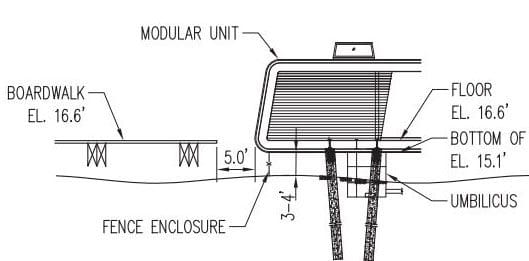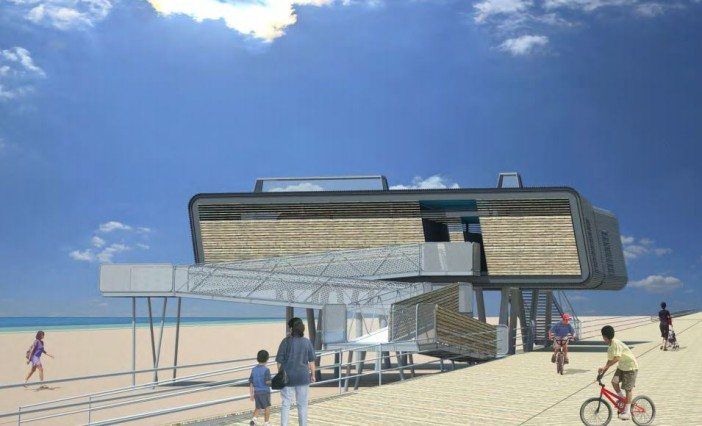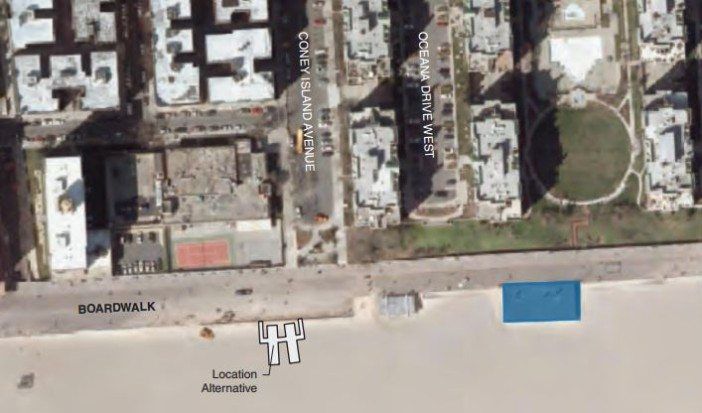City Taxpayers To Shoulder $2.5 Million Loss On Brighton Boardwalk Bathrooms


EXCLUSIVE: Approximately $2.5 million in taxpayer dollars is being flushed down the drain, as the city caves to the demands of luxury condominium dwellers to move bathrooms on the Brighton Beach boardwalk.
The New York City Parks Department confirmed to Sheepshead Bites that the city has already spent $5 million on the controversial comfort station, originally slated for the Riegelmann Boardwalk between Coney Island Avenue and Seacoast Terrace. All of that money was expected to be covered by recovery funds from the federal government. But now that the agency has agreed to abandon the partially completed project, city taxpayers are stuck with a bill for $2.5 million.
Though it might seem like a waste, the department said it’s the cost of reversing the wrong of a previous administration.
“Although we have also spent $2.5 million on non-transferable work at the original site which was selected by the previous administration, the new site will better serve beachgoers and adheres to our policy of not placing comfort stations in front of residential buildings whenever possible,” said Sam Biederman, the Parks Department’s assistant commissioner for communications.
The remaining $2.5 million already spent is recoverable, since it was the cost for the RV-like structures themselves – and they can be transferred to the new site just west of Coney Island Avenue, in front of the Shorefront YM-YWHA.
The department does not yet have an estimate on the final costs for the new site.

The placement isn’t just a change in location, it’s a new design.
The Parks Department under Mayor Michael Bloomberg already rebuilt comfort stations at 15 other sites across New York City, including three other locations on the Riegelmann Boardwalk. Those designs elevated the structures on stilts 25 feet above the beach, putting it out of reach of even the largest storm surges as a long-term resiliency measure.
The revised proposal for only the Brighton Beach location, however, will be raised just eight feet off the sand – the exact same height as the boardwalk itself. No ramps will be built, and beachgoers will be able to access it directly from the boardwalk.
Again, the Park Department said the previous administration was overly cautious, building above the 500-year-flood line, while the new building will still be above the 100-year-flood line, approximately the size of Sandy’s storm surge.
“The new proposed site at Coney Island Avenue meets the federal height requirement [for reimbursement], and provides protection while improving beachgoers’ experience. The 500-year BFA height was determined by the previous administration directly after Sandy and is a very conservative benchmark,” said Biederman.

The department defended the new design in its final environmental impact study released this week, noting that it would “reduce the visual prominence of the structure.”
The previous administration, however, argued that it was not only more resilient, but preferable for the public, which would be provided unobstructed views of the ocean from the boardwalk.
“The height of the modular structures was designed to provide clearance above the boardwalk in order to allow boardwalk patrons to walk underneath and to provide views from the boardwalk to the ocean through the structural supports,” the Parks Department, under the previous administration, wrote in its draft environmental impact study.
The new design and location change, though, appears to favor the ocean views of a handful of homeowners over the public.
The changes came at the urging of Oceana condominium residents. They argued during public hearings that the original site, just outside of their building, would cause odors and unwelcome guests. Meanwhile, they also argued that the height of the structure – topping out at more than 20 feet about the boardwalk – would block their oceanfront views.
But at least one local activist says the decision is hypocritical, with the administration refusing to buckle over another longstanding aesthetics controversy fought by less well-heeled community members.
“If you’re moving something or changing it or whatever for aesthetic concerns or response to the community, what about the community’s concerns on another issue – making the boardwalk concrete – in an identical location?” said Brighton resident Ida Sanoff. “How come one is responding to the community and the other is ‘Oh, screw you?'”
“I think it’s called pandering,” she continued. “The people in Oceana, they’re quite well to do.”
Clarification (April 9 at 3:00pm): A line saying that the new bathrooms are believed to be full funded by federal aid was removed from this post. While Parks expects the station to be funded by federal aid, it is too early in the process to determine the amount of funding with any specificity.




